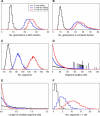The genomes of recombinant inbred lines
- PMID: 15545647
- PMCID: PMC1449115
- DOI: 10.1534/genetics.104.035212
The genomes of recombinant inbred lines
Erratum in
- Genetics. 2006 Aug;173(4):2419
Abstract
Recombinant inbred lines (RILs) can serve as powerful tools for genetic mapping. Recently, members of the Complex Trait Consortium proposed the development of a large panel of eight-way RILs in the mouse, derived from eight genetically diverse parental strains. Such a panel would be a valuable community resource. The use of such eight-way RILs will require a detailed understanding of the relationship between alleles at linked loci on an RI chromosome. We extend the work of Haldane and Waddington on two-way RILs and describe the map expansion, clustering of breakpoints, and other features of the genomes of multiple-strain RILs as a function of the level of crossover interference in meiosis.
Figures






References
-
- Complex Trait Consortium, 2004. The Collaborative Cross, a community resource for the genetic analysis of complex traits. Nat. Genet. 36: 1133–1137. - PubMed
-
- Hospital, F., C. Dillmann and A. E. Melchinger, 1996. A general algorithm to compute multilocus genotype frequencies under various mating systems. Comput. Appl. Biosci. 12: 455–462. - PubMed
-
- Ihaka, R., and R. Gentleman, 1996. R: A language for data analysis and graphics. J. Comp. Graph. Stat. 5: 299–314.
MeSH terms
LinkOut - more resources
Full Text Sources
Other Literature Sources

